
Transcription
Guide to Google AdWordsGoogle’sEnhancedBeginner Edition(Revised)Campaigns - 5 thingsyou need to knowWhat the AdWords Update Means for Your Paid Search Strategyhanapinmarketing.com
Beginner EditionGuide to Google AdWordsStarting in PPCSo you’ve taken the plunge into PPC. Welcome to the club! There is a lot that goes on in PPC. Luckily foryou it is also one of the most open communities when it comes to sharing. If you run into any problems,you can quickly find help through forums, twitter, or the multitude of great PPC blogs.This paper will focus mostly on Google AdWords, the largest PPC platform, but the same concepts areapplicable across the other platforms as well. By the end of this article, you will feel comfortable withcommon terminology and concepts.How PPC WorksPPC stands for pay per click. You may also see it attributed as cost per click. This advertising modelcharges the advertiser when the ad is clicked, not when the ad is shown.If a user sees an ad but does not click it, the advertiser isn’t charged. This allows advertisers to optimizeads around getting clicks and specific actions rather than buying advertising space in bulk and hoping forthe best.In AdWords, ads are chosen in an auction system. Each competitor sets bids for certain search terms.Google runs an auction for each query and displays the ads of the winners in order of their standing(based on the bids and relevance).The ads are sorted by Ad Rank. Ad rank is simply the quality score X bid. The quality score is a metricderived solely on Google’s end, and rates the ads on the relevancy factors. So, advertising towardsrelevant users could actually be cheaper; a higher quality score means a lower bid, which means youcould win the auction with a cheaper bid.PPC is a data heavy field and built around optimization. The ad platforms collect data on the associatedmetrics, allowing you to optimize your account as needed to increase your sales, decrease yournon-converting spend, and get more bang for your buck.hanapinmarketing.com
Guide to Google AdWordsWhat is in an Account?There are only a few primary pieces to an AdWords account. Each piece is pretty simple and the biggestlearning curve will come with organizing and putting the components together.CampaignsThe highest-level grouping is the campaign. Each campaign has its own settings, budget, andorganization. You could devote certain campaigns to specific themes or geographic areas. The choiceis up to you. There are no hard rules for how many campaigns you should have either. Don’t worryabout creating new ones for special promotions or just to try something new. You won’t run out ofthem and you can stop them at any time.One of the biggest uses for campaigns is to group selected ad groups that target specific usersegments. Grouping ad groups could entail a campaign for basketball shoes, another for baseballcleats, and a third campaign for casual shoes. This eases the burden on the manager, as they canquickly find and access the relevant parts of their account.Ad GroupsAd Groups are the smaller containers that exist within each campaign. They are called ad groupsbecause they contain a group of keywords that trigger the same group of ads.This ad group structure can be more important than campaign structure. Ad groups should be moretightly tailored to themes in keywords and ads. This not only helps your relevancy in the eyes ofGoogle, but also ensures that your ad copy is targeted towards the correct searchers. You wouldn’twant to show the same ad to users who search for basketball shoes as you do for users searching fordress shoes.Similar to campaigns, you aren’t limited by the number of ad groups, so there is no need to overfill adgroups with keywords. If you think a large ad group could be split into two more specific ad groups, goahead and do it. It’ll only make the account easier to manage in the long run.hanapinmarketing.com
Guide to Google AdWordsKeywordsKeywords are the phrases and words used to target searchers queries. They come in a few varieties:broad, modified broad, phrase, and exact. You may see these with the match type notation as well.Broad has no punctuation, modified broad has , phrase is enclosed in “ ”, and exact is enclosed in [ ].Broad: red shoesModified Broad: red shoesPhrase: “red shoes”Exact: [red shoes]So what is the exact difference between the types? Broad match can match to any query containing those terms or their synonyms in any order. Broad modified is similar to broad but requires that the terms with are included,eliminating the synonyms. Phrase requires the query to contain those terms in that specific order, but anything couldappear before or after the phrase. Exact is the most specific, only triggering ads when that specific query has been entered.Choosing keywords requires a balance. Broad will bring in the most traffic but may bring irrelevantsearches, while exact will bring qualified traffic at lower volumes. Since broad, is well broad, ispresents some dangers of driving a lot of spend for only a little gain. What if you need to block certainsegments of traffic to control this flow?Thankfully, you can control incoming traffic with negative keywords. Negatives have the same matchtypes but work in reserve, keeping ads from showing for any queries containing those terms.For example red shoes could trigger an ad for a searcher looking for red heels. In this example, youraccount only stocks athletic shoes. You can then apply red heels as a negative to remove thesesearches from triggering your ads.hanapinmarketing.com
Guide to Google AdWordsKeywords cont.You can view the searches that triggered your ads from the search term report. This report can bereached from the keyword tab in your account. You can view search terms for the entire accountdown to specific keywords.AdsAds themselves are specific to their containing ad group. They are subject to certain limitations.Headlines can be up to 25 characters, description lines 1 and 2 can be up to 35 characters, displayURLs can be up to 35 characters, and destination URLs can be just about as long as they couldpossibly need to be.The ads themselves are pretty short. While this means they can be quick to write, the limitations alsoadd to the challenge. With just 70 characters for descriptions lines you’ll often have to stretch yourcreativity to include the desired message and meet the length requirements.The headline is what you see at the top of the ad. These should be tailored to the ad group themeand keywords. The description lines should describe the benefits, any selling points, and a call toaction. The display URL needs to target your domain, but as the name suggests, it is actually only forappearances. The destination URL is not seen on the surface, but is the address the searcher is sentto when clicking the ad.hanapinmarketing.com
Guide to Google AdWordsAds Cont.Looking at the ad above, you might wonder why certain parts are highlighted. Those are terms thatmatched the query used to find this ad. The query was for Google products. Whenever ad copy matchesthe query, those parts of the ad will be highlighted. This is one of the main reasons to have tightlyfocused ad groups and ads, since your ads will draw a little more attention with the bolded text.You can have as many ads as you want in an ad group. Despite this, it is often best to run two ads ineach ad group. This allows you to easily test two variations against one another. After a period oftime, you can go back to your ad group and replace the poorest performing ad with a new ad andrestart the testing cycle. You’ll soon embrace this though. It’s one of the driving forces in PPC.You won’t always have a winner right away, but you can always keep testing and getting better.The Common MetricsThe common metrics you need to know right off the bat are: Clicks Impressions Conversions Revenue (maybe, depending on the business)These form the foundation for almost all of the other metrics you need to optimize performance.Impressions are how many times your ad is shown. Each time a user sees your ad during a search, animpression is tallied. If a user clicks on the ad you gain a click. These metrics are collected at both thekeyword and ad level, as well as aggregated at the ad group, campaign, and account level. Thisgranular detail allows you to optimize each part of the account independently. This will help youfigure out which part of the campaign is successful, rather than trying to find the perfectcombination of elements.Clicks and impressions are also used to calculate click through rate, or CTR, which is simplyclicks/impressions. This ratio tells you how often your ads are clicked, allowing you to troubleshootcomponents that just aren’t working. That said, there is no “good CTR.” It is relative and you’ll haveto learn over time where your account’s baseline is. Don’t fret too much over this metric, but yougenerally want it to be higher.hanapinmarketing.com
Guide to Google AdWordsThe Common Metrics Cont.Conversions are goal completions. This can be imported through Google Analytics but are alsocommonly used with an AdWords tracking code. The most common scenario is to place a conversioncode on the checkout confirmation or form submissions page. Each time a user clicks the ad and thengoes on to reach the final page, a conversion is totaled. This gives you an accurate count of how oftenPPC ads drive direct sales or leads. This metric also lets you calculate the cost/conversion or CPA/CPL,how much are you spending for each sale or lead.Working in The AccountOne of the first tests of managing an account is getting used to the interface. Get comfortableflipping through your account and adjusting the date ranges, graphs, and metrics. This is going to be yourfirst line of defense in monitoring account performance. Anytime you see significant changes or even along running trend, go ahead and examine the change history. This page keeps a record of all the changesin your account whether they were new ads, keywords, adjusted bids or budgets, or when you pausedand enabled certain elements.You’ll find that you can make any adjustment needed through the interface. This brings up twoproblems though. The first problem you’ll face is that anything done through the interface is instantlyapplied. What if you want to double-check your changes before finalizing them?The second problem you’ll have is making large-scale changes. Thankfully, there are tools to addressthis. Excel and AdWords Editor will become your best friends soon enough.The AdWords editor is a program provided, free of charge, by Google. It allows you to download a copyof your account into the program. You can then tweak and apply changes to the accountwithout them going live. This also makes it easy to revert changes if you change your mind. Whenyou are ready to implement your changes, simply click the button and the editor will sync with youraccount.When it comes to analyzing your account, it’s easiest to do it in Excel. You can download just aboutanything from AdWords in an Excel useable format. You can then use Excel to apply custom formulasfor bid changes or to build completely new ad groups and keywords. Once you’ve finished your work inExcel, you can directly insert your spreadsheet into AdWords Editor and load the changes.hanapinmarketing.com
Guide to Google AdWordsWorking in The Account Cont.Working in Excel also offers you the flexibility to manipulate the data as needed. The most commontechniques you can use are functions and pivot tables. Functions allow you to use logic to manipulateand analyze data. For example, you can bid down by 10% on all keywords over CPA and bid up by 10%for any keyword under your CPA goal. This would be a long task through the editor, but would takeminutes in Excel.Pivot tables can and have provided papers worth of information in their own right. They are worthmentioning though, as they will be a crucial tool in your account work and professional tasks. Pivottables simply allow you to create custom tables using your own parameters. For example, you couldquickly take a standard keyword report and analyze match type performance then swap a few fieldsand check the number of keywords in each ad group.This is only the Beginning So there you have it, common terms and concepts to get you started in PPC. We’ve only just scratchedthe surface in Google Adwords; next up are optimizations, experiments, display network campaigns, andmore. The list goes on and on.Remember, if you need help, there are plenty of resources available out there. Just Google it or betteryet, start your search on PPC Hero.A Quick RecapThe Seven Account Management Tasks You Need to Succeed Early in PPC1. Make bid changes in bulk through the AdWords Editor2. Monitor and understand performance through the AdWords interface3. Perform search query reports to find new keywords and eliminate poor quality traffic4. Write creative ads and test, test, test!5. Establish goals and guidelines for performance6. Be flexible with adjusting your spend7. Never stop learning - new techniques and tips pop up all the timehanapinmarketing.com
Learn more with Hanapin.For help with your Paid SearchCampaigns, or to talk to a paid searchprofessional, contact us:www.HanapinMarketing.com812.330.3134Hanapin Marketing is a paid search agency based in Bloomington, Indiana. Founded in 2004, the companyhanapinmarketing.commanges & optimizes clients’ paid search programs—increasing sales while simultaneouslydecreasing budgets.From ad copy composition to keyword research to landing page optimization, Hanapin’s core objective is tomaximize our clients’ return on investment.
this. Excel and AdWords Editor will become your best friends soon enough. The AdWords editor is a program provided, free of charge, by Google. It allows you to download a copy of your account into the program. You can then tweak and apply changes to the account without them going live. Th

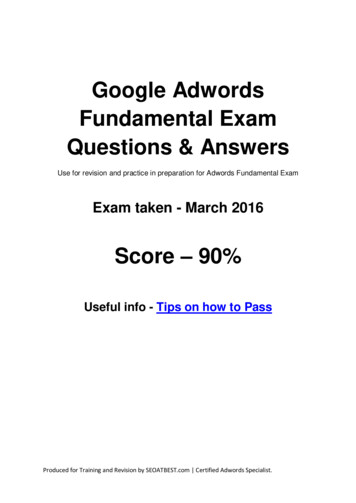
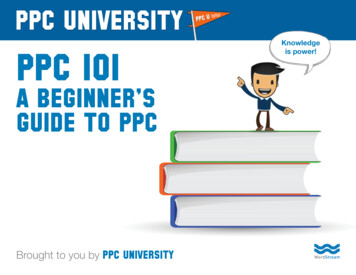
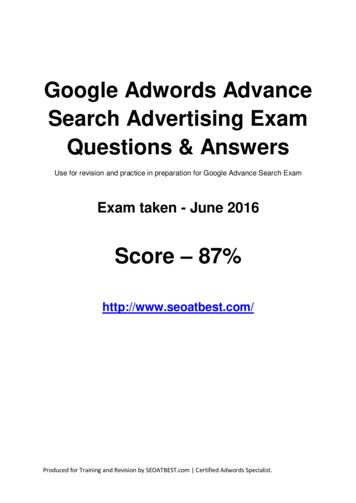

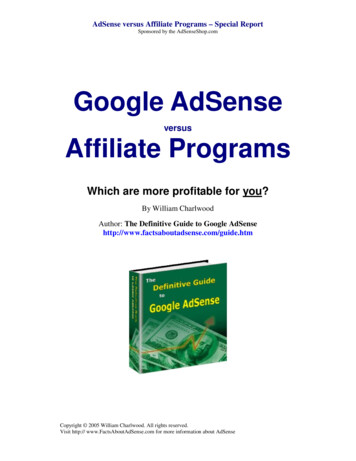

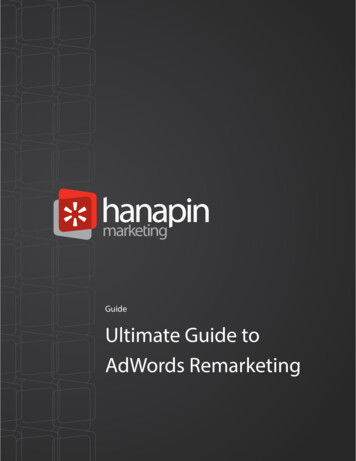
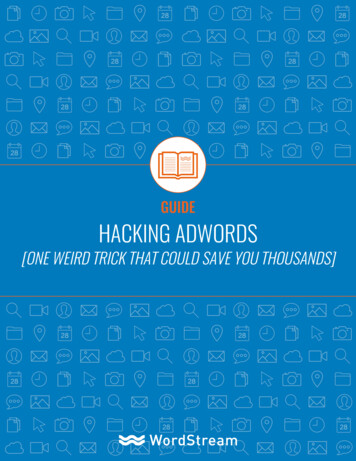
![[ A BEGINNER’S GUIDE ]](/img/11/beginners-guide.jpg)